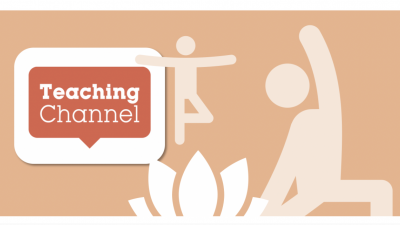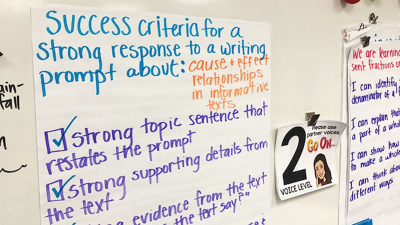Transcript for The Iditarod and Math -Todd Hausman
4, 3,2,1Go! The lditarods led that race and it's a race in Alaska, it starts in Anchorage and it goes all the way to Nome. It's a 1150 mile sled dog race, it started on Saturday March sth,and it will end when the first team arrives in Nome Alaska. My name is Todd Hausman and I'm a 4th grade teacher in Bellingham, Washington. My students have been studying the lditarod and we've also been studying elapsed time. When mathematicians talk about elapsed time what are we talking about? What are people doing?
Student-"Are we going to use the lditarod?"
Elapsed time is actually a really tricky concept for a lot of students and the lditarod is a great opportunity for them to use real authentic data to explore elapse time. But the really nice thing about the lditatrod is it really appeals to students,both because they enjoy watching the dogs, and the stories of the actual competitors themselves are just remarkably compelling.
Student- "At 9 o clock this morning I checked, Martin Buser was first,Lance Mackey was second..." Student- "I'm surprised that Dallas Sedy isn't in, like in 4th place or 6th place..."
Student- "I checked before Iwent to school,and he is still at Takotan resting his camp,he has 12 dogs..."
Today what the students are going to be doing is going on to the lditarod website, they are going to be looking up where their mushers are at this morning,and then they are going to be making some predictions about where their mushers are going to be or what time their mushers are going to arrive in the checkpoint of lditarod. So it's actually a fairly complex task because what students have to do,is
they have to look at the mile marker that the mushers are on today,they have to think about the mile marker that the mushers are going to be at in the near future, and they have to estimate how long it's going to take the musher to go from point A to point B. I'm going to stick with Martin ok? Let's use Martin Buser as an example,so Martin Buser arrived at the Takotna checkpoint at 8:16pm. Alright now let's think about that,the one thing we could do is we could measure how much time has passed since he's been at the checkpoint. Ethan do you have a question?
Student- "We need to add 24 hours onto our prediction because the mushers are going to take their 24 hour break somewhere before the town of lditarod."
So let's talk about that,that's really important,I think that we can assume based on what we know about our musher is that this is his 24 hour rest point ok? So if he came in at 8:16pm last night, that means he has to wait until 8:16pm tonight 3/9 before he can leave. You're familiar with this page,this is the live GPS tracking page so Martin is at mile 307 right now,and the lditarod checkpoint Tim is I think this one, where this trail breaker is right there. You can see that the goal is to get to mile 405, how many miles does he have to travel between Takotna and lditarod? What's the difference between those two numbers there? What did you get Trishana? 98...98 ok? So we know Martin has 98 miles to go before he gets to the town of lditarod,if he gets there first he gets $3000 dollars and gold medals right? So now what do we do? How are we going to figure out our estimate, we know what time he is going to leave or what time we think he is going to leave...and we know how many miles he has to travel,so how are we
going to deal with coming up with a reasonable estimate.
Student -"The speed...how fast he's going" so how fast would you estimate? 9 or 10. Ok 10 is a nice easy number,Coal what does that tell us?
Student- "9 hours and 8 tenths"
"Ok Jacob what would you do with 9 and 8 tenths?" Student- "One 5th of 60 is 12 and 12 x 4 is 48."
So you would actually be able to say that's 9 hours and 48 minutes.So we can say that Martin will arrive in lditarod at 6:16am. Now either you or your partner and if you're not sure do rock paper scissors quickly, but one of you needs to get a laptop computer and open up the lditarod.com site...
What will happen is students will break up into pairs and that's partly because we have a limited number of laptop computers, so it's a logistical decision but it's also a decision that helps students because
having a partner gives them somebody they can work with,somebody they can talk to somebody they can throw ideas off of,and then they can work together to kind of, come up with some strategies that will be effective for them. They will be using a couple of different websites,they will be using the lditarod.com website which has the real live GPS data on it,and they' ll also be using a wiki site that I've created for the students where they can then post their predictions online. That's a nice accountability piece for me it allows me to go back later and look at the predictions they made,and it also gives them an opportunity to go back and compare their predictions once the mushers have arrived at their final destination.
Student-"We guessed that Sebastian Shoy was going to take his 24 hour rest at Takotna so we just did the same time next day,and then we figured out what mile marker he was at,and figured out what mile marker lditarod was at and found the difference which was 98. Then we did 98 divided by 9 which we thought 9 was his average speed so we got 10.8 and then we did the 8,9,ihhour was 53 minutes so it would take him 10 hours and 53 minutes to get to lditarod so we added that on to the time that he left and we got 20:68 and we converted that to the actual military time which was 21:08 and then Sebastian Schnuelle will arrive in lditarod at 21:08 on the date of 3/10/11."
One of the things about math is that math is a way for people to try to make sense of the natural world, and I think that's how math was developed and I that's why people continue to really rely on math. The wonderful thing about this race is we don't know, there's no right answer there's no wrong answer and there's no way that any of us can prove whether or not the predictions are accurate,the goal isn't to get the right answer,the goal is to use the mathematical skills that they have to be able to come up with a prediction that's reasonable and that they can defend logically.So it really is a wonderful experience for them to have,and the best part is you know they get to develop it and explore it on their own.









18 Comments
Christopher Sch... Jan 16, 2023 5:52pm
I enjoyed how students can make their own estimates on when sled arrive and then they can compare their estimates with the actual arrival times.
Jane vonBirgelen Feb 22, 2022 4:03pm
I also love teaching about the Iditarod. There are endless amounts of math concepts involved in the race. I have a curriculum that I have pulled together between other teachers and my own resources. Kids do love learning about the dogs. They get even more engaged if their families take them to the ceremonial start in Anchorage. Elapsed time is one of the hardest concepts to teach. I like that this teacher focused on this area, and the kids called it by name.
Clarisse Sudi May 24, 2021 2:04pm
this video is very interesting, especially to see the commitment and involvement of the whole class and the active collaboration, even more to see children engage in personal research at the level of their home to allow them to have more element for their job; and it is so interesting to see the teacher take a concrete example of real life not for the purpose of having the right or the wrong answer but rather to push the students to go beyond their limits
Julio Jacobo-Ma... May 2, 2020 8:09pm
I really enjoyed how the teacher, Todd Hausman, incorporated real life events to the math lesson. The Iditarod dog race is an excellent activity to combine the learning of elapsed time, predicting events and get the kids involved with technology and teamwork. One of my favorite parts was to see how engage the class was with this activity. Kids were talking about waking up early and checking up on the race first thing in the morning. I like the participation during class discussion and whenever the kids were making predictions on whom would be on first place the next day, made the kids explain their reasoning behind their prediction. My only concern with this activity is to find a way to make it suitable for our EL students. I can think of a lot of ways to implement this activity in the classroom so I will definitely keep it in mind for next school year.
Yahel Aragón Mar 11, 2020 10:06am
He pairs students (paartly because there are not so many for everyone)...
He uses real life informtion about real life time and places.
They can share information in pairs.